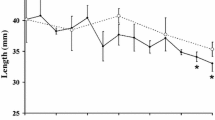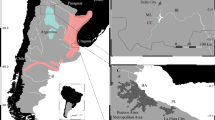Abstract.
We examined the mechanism by which Antarctic krill, Euphausia superba, shrink, and suggest that cellular changes occurring during shrinkage may provide a means for identifying krill that have undergone shrinkage. We compared the muscle tissue of juvenile, adult and shrunken adult krill to identify changes in cell number associated with maturity and shrinkage. Comparison of the absolute number and density of nuclei in abdominal segments of juvenile, adult and shrunken adult krill revealed differences related to maturity and shrinkage. Shrunken adult krill had nearly twice as many nuclei per unit area than adult krill that had not shrunk. This suggests that krill shrink by a reduction in cell volume, rather than cell loss. This simply detected variation in muscle cell nucleus density may be useful in distinguishing shrunken adult krill from juveniles, and contribute to our knowledge of age structure in natural populations.
Similar content being viewed by others
Author information
Authors and Affiliations
Additional information
Electronic Publication
Rights and permissions
About this article
Cite this article
McGaffin, A.F., Nicol, S. & Ritz, D.A. Changes in muscle tissue of shrinking Antarctic krill. Polar Biol 25, 180–186 (2002). https://doi.org/10.1007/s003000100325
Accepted:
Issue Date:
DOI: https://doi.org/10.1007/s003000100325




